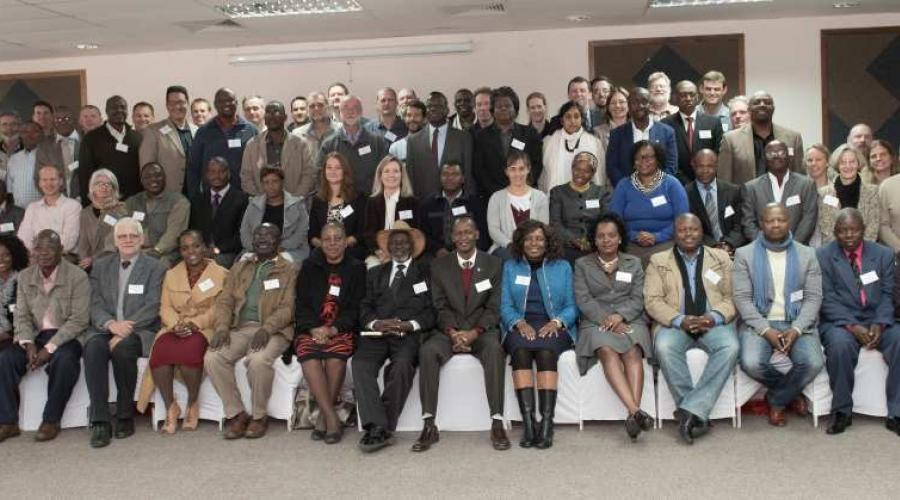TFCA Network Discuss New Partnership Models for Saving Biodiversity during Landmark Symposium
In July this year, the SADC Transfrontier Conservation Area (TFCA) Network conveyed its landmark regional expert symposium on Conservation, Collaboration and Management support. Objective of the network is to facilitate information sharing, joint learning, resource mobilisation and strengthening collaboration between its members on the cross border management of natural resources and sustainable rural development. Currently the Network has over 250 registered members from Governments, private sector, regional and international NGOs, and TFCA practitioners. They communicate through an online portal and regular face to face meetings. This first ever TFCA related symposium opened a regional platform for dialogue, joint learning and information exchange to enhance collaboration.
The objective of the three-day symposium was to present innovative models of partnership arrangements in protected areas (PAs) in the SADC region. More than 100 experts from SADC Member States’ wildlife authorities, NGOs, private sector, communities and the donor community came together to deepen their expertise and map the way forward. The Permanent Secretary in the Ministry of Environment, Wildlife and Tourism of Botswana Mr Elias Magosi and the Director of the SADC Secretariat’s Food and Agricultural and Natural Resources Department Mrs Margaret Nyirenda opened the symposium. In their opening statements, both underlined the importance of cross border cooperation to foster regional integration. Mr. Magosi further emphasised “The proceedings from the SADC TFCA Network Symposium should be harnessed to promote uptake by policy and decision makers; as well as to develop benefit-sharing models which are sensitive to the needs of the different sectors of the community, and are based on accountability”.
New partnership models between public and non-public actors are an important approach to counteract the impact under-financed and under-staffed protected areas, increasing pressures through human expansion of agricultural lands and poaching. These models foster collaboration between stakeholders and increase efficiency as the partners contribute different skills, human and financial resources. Over the last years some very innovative partnership models emerged in the region. They include the collaboration of Wilderness Safaris (private sector operator) and Botswana Department of Wildlife and National Parks in the Moremi Game Reserve, where both partners have joined forces to improve anti-poaching efforts combined with to the re-introduction of species such as rhinos to the Okavango Delta. In other National Parks government institutions have shared management agreements whereby a NGO such as African Parks takes over day-to-day management responsibility under the guidance of a joint steering committee.
As others have observed, the symposium affirmed the notion that communities play a vital part in conservation. Community involvement is the key to achieve long-term conservation objectives in PAs and TFCAs. Most of the region’s large-scale conservation initiatives are still falling short on their promise to help bring about socio economic development. Without incentives for communities to become stewards of biodiversity and attain livelihood the pressure on the natural resources can seriously affect biodiversity loss, tourism potential and resilience to climate change. Some participants at the symposium shared successful models of community engagement. One such interesting example is the Richtersveld National Park in South Africa. Here, the owners of the national park lands are the local Nama people who in turn have commissioned the governmental wildlife authority South African National Parks (SANParks) with the management of the protected area on their behalf and for their benefits.
One of afternoons the participants visited the International Law Enforcement Academy Gaborone. At the academy one of the burning issues brought to the fore was that a significant portion of poaching and illegal wildlife trade is carried out by organized criminal networks, drawn by the low risk and high profit nature of these crimes and how communities get drawn in as a result of poverty. Wildlife criminal networks operate like global multinational businesses, connecting local resources to global markets through complex and interlinked networks often embedded in the business community and the public sector, sometimes including those tasked with protecting the wildlife. This has far reaching consequences and is both a conservation and livelihood issue. At the symposium participants stressed the importance of collaboration between SADC Member States through instruments such as the recently adopted SADC Law Enforcement and Anti-Poaching Strategy.
The SADC TFCA Network Symposium 2016 was a milestone for the still fledgling network but it highlighted what conservation could achieve over the next years if all the stakeholders come together and work jointly to achieve common goals. The symposium was supported by the German Development Cooperation through SADC-GIZ TUPNR and the cross-cutting political cooperation fund (Polifund) project “Combating Poaching and the Illegal Trade in Ivory and Rhino-Horn”, Peace Parks Foundation, IUCN BIOPAMA programme, Frankfurt Zoological Society, Panthera and African Wildlife Foundation.


